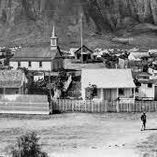
Kalaupapa National Historical Park
Established in 1980 to preserve the memories and experiences of the people forcibly sent here. Kalaupapa National Historical Park’s mission is to provide a well-maintained community that ensures the present patient-residents of the Kalaupapa Settlement may live out their lives peacefully and comfortably by honoring the moʻolelo (story) of the isolated Hansen’s disease (leprosy) community and preserve and interpret its site and values.
The Early Years: 1866 - 1900
The government expected patients to move into the houses left behind by the Hawaiians and grow crops to sustain themselves. It quickly became apparent that most patients were too ill or demoralized to be self-sufficient. Reports of the insufficient housing and lack of supplies were soon filed by the patients and their families, by the resident superintendent, and by Board of Health Agent Rudolph W. Meyer, who lived on the palioverlooking the settlement.
Hawaiian people hid their afflicted relatives and friends, hoping to prevent their discovery and banishment to a certain death, but as the ramifications of the disease unfolded and stories of the deplorable conditions spread, family members chose to go into isolation with their loved ones as a kokua, or helper. Husbands had been separated from their wives and children, diseased children were removed from their mothers and fathers, and babies born to patients were immediately taken by health officials to be placed in the care of relatives or taken to orphanages.
Nevertheless, Hawai'i did more for its people with Hansen's disease than any country in history up to that time. The board of health had made efforts to improve conditions, including building a hospital and homes, and supplying food, clothing, housing, and medical care, but it could not keep up with the numbers of people being sent to Kalawao.
Starting in 1873, major improvements were made due to the arrival of Father Damien and the interest and support of the next two Hawaiian Kings, William Charles Lunalilo and David Kalakaua.
From 1888 to 1902, the isolation laws in Hawaii were strictly enforced, and the population at Kalawao swelled to over 1,100 people. Also during this period, Mother Marianne Cope and the Sisters of St. Franci opened the Bishop Home for Girls, while Brother Joseph Dutton and Brothers of the Sacred Heart ran the Baldwin Home for Boys.
In 1893 and 1894, the centuries-long habitation of the Kalaupapa Peninsula by non–patient Hawaiian people came to an end. All non-patients were removed, and the last remaining private property was purchased. The board of health took steps to manage the last remaining non-patient Hawaiians living in Kalaupapa and on the peninsula. Due to the warmer and drier climate and the capacity to better land freight and passengers, the isolation settlement was expanded to include not just Kalawao and the entire peninsula including all trails and lands to the top of the pali. Water lines were extended from Waikolu Valley to bring a fresh supply of water.

The 20th Century: 1900 - 1945
Starting in 1900 the Board of Health implemented a major construction program on Kalaupapa. The program provided a higher quality of services that included better medical facilities, procedures, and treatment of patients and more utilities. The program also provided individual cottages, dormitories, and sporting facilities. In 1902 Dr. William J. Goodhue became resident physician and John D. McVeigh became the settlement's superintendent and worked to improve the quality of life within isolation.
Over the years, the Board of Health ‘s record documents how the disease knew no racial or ethnic boundaries. In 1903, its annual report showed the total patient population at Kalaupapa to be 888 people – 541 males and 347 females. Of that number, 459 males and 338 females were Hawaiian. Oher major racial groups were also represented: 40 Chinese men and 3 Chinese women; 12 Portuguese men and 2 Portuguese women; and seven "American" men and one "American" woman.
From 1909 – 1913, the Federal Government of the United States of America built two facilities on the peninsula: The Moloka`I Light Station and a hospital complex in Kalawao to conduct Hansen's disease research.
The Public Health and Marine Hospital Service operated the US Leprosy Investigation Station. By 1919 treatments of chaulmoogra oil, derived from seeds of trees found in India and Southeast Asia, offered hope as a cure for Hansen's disease. By 1924, the patient population had been reduced by almost half.
By the 1930s Kalaupapa's physical infrastructure needed an overhaul and Governor Lawrence M. Judd of the Territory of Hawai'i undertook further construction and rehabilitation projects.

The 20th Century: 1945 - Today
With the discovery of sulfone drugs after WWII, impacting changes in both the treatment of Hansen's disease and in social attitudes towards patients took place. Sulfone treatments were introduced into Hawaii in 1946 and vast improvements in the quality of health and life brought immediate reductions of symptoms to the patients.
In 1947, Former Governor Lawrence M. Judd became superintendent of Kalaupapa. With his wife, Eva Marie, physical barriers separating patients from workers were removed, and social activities and adult education classes were promoted: Boy Scouts, Girl Scouts, Lion's Club, American Legion, and other organizations.
By 1969, new drug therapies had proved effective, and the century-old laws of forced quarantine were abolished because Hansen's disease patients were no longer contagious and isolation was no longer required.
Kalaupapa has been home for 100 years for people once banished from society. The patient population has decreased dramatically, but former patients remain in the much quieter settlement.








